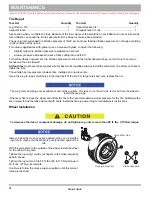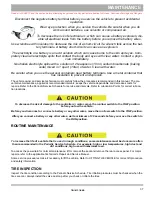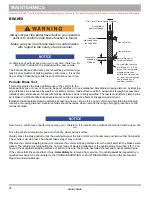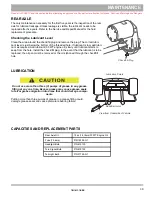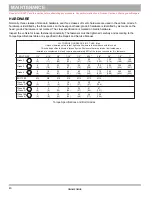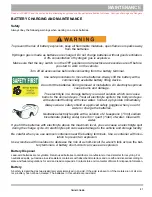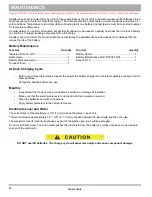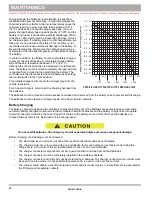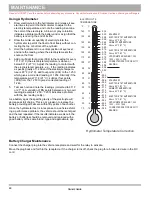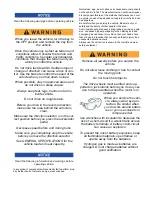
48
MAINTENANCE
Read all of SAFETY and this section before attempting any procedure. Pay particular attention to Notices, Cautions, Warnings and Dangers.
Owner’s Guide
Using A Hydrometer
1.
Draw electrolyte into the hydrometer and release it sev-
eral times to permit the thermometer to adjust to the
electrolyte temperature and note the reading. Examine
the color of the electrolyte. A brown or gray coloration
indicates a problem with the battery and is a sign that the
battery is nearing the end of its life.
2.
Draw the minimum quantity of electrolyte into the
hydrometer to permit the float to float freely without con-
tacting the top or bottom of the cylinder.
3.
Hold the hydrometer in a vertical position at eye level
and note the reading where the electrolyte meets the
scale on the float.
4.
Add or subtract four points (.004) to the reading for every
10° F (6° C) the electrolyte temperature is above or
below 80° F (27° C). Adjust the reading to conform with
the electrolyte temperature, e.g., if the reading indicates
a specific gravity of 1.250 and the electrolyte tempera-
ture is 90° F (32° C), add four points (.004) to the 1.250
which gives a corrected reading of 1.254. Similarly if the
temperature was 70° F (21° C), subtract four points
(.004) from the 1.250 to give a corrected reading of
1.246.
5.
Test each cell and note the readings (corrected to 80° F
or 27° C). A variation of fifty points between any two cell
readings (example 1.250 - 1.200) indicates a problem
with the low reading cell(s).
As a battery ages the specific gravity of the electrolyte will
decrease at full charge. This is not a reason to replace the
battery providing all cells are within fifty points of each other.
Since the hydrometer test is in response to a vehicle exhibit-
ing a performance problem, the vehicle should be recharged
and the test repeated. If the results indicate a weak cell, the
battery or batteries should be removed and replaced with a
good battery of the same brand, type and approximate age.
Battery Charger Maintenance
Connect the charger plug into the vehicle receptacle and wait for the relay to activate.
Move the plug back and forth in the receptacle. If the charger turns off, check the plug for a broken red wire in the DC
cord
Hydrometer Temperature Correction
°F °C
160 71
150 65
140 60
130 54
120 49
110 43
100 37
90 32
80 26
70 21
60 15
50 10
40 4
30 -1
20 -6
10 -12
+.032
+.028
+.024
+.020
+.016
+.012
+.008
+.004
0
-.004
-.008
-.012
-.016
-.020
-.024
-.028
+.030
+.026
+.022
+.018
+.014
+.010
+.006
+.002
-.002
-.006
-.010
-.014
-.018
-.022
-.026
EXAMPLE #1
ELECTROLYTE TEMPERATURE
Above 80 °F (27 °C)
AMBIENT TEMPERATURE
Above 80 °F (27 °C)
ELECTROLYTE TEMPERATURE
Above 90 °F (32 °C)
HYDROMETER READING 1.250
1.250 + .004 = 1.254
CORRECTED SPECIFIC GRAVITY
READING
EXAMPLE #2
ELECTROLYTE TEMPERATURE
Above 80 °F (27 °C)
AMBIENT TEMPERATURE
Above 80 °F (27 °C)
ELECTROLYTE TEMPERATURE
Above 70 °F (21 °C)
HYDROMETER READING 1.250
1.250 - .004 = 1.246
CORRECTED SPECIFIC GRAVITY
READING
ELECTROLYTE
TEMPERATURE
Summary of Contents for Hauler 800XE
Page 1: ...OWNER S GUIDE 642988 B HAULER 800XE REVISED FEBRUARY 2016 ISSUED FEBRUARY 2015...
Page 61: ......
Page 62: ......

